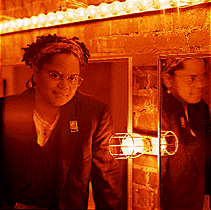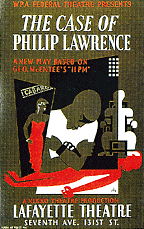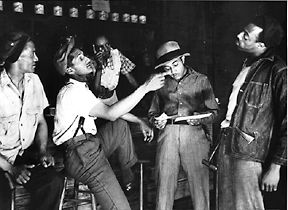 Valerie
Curtis-Newton. Photo by Mary Levin.
Valerie
Curtis-Newton. Photo by Mary Levin.By Nancy Wick
What Valerie Curtis-Newton found in a book spawned a dream. The year was 1990. The place was a friend's house in Hartford, Conn. During a dinner party, Curtis-Newton gravitated toward the library. Idly, she browsed through Free, Adult, and Uncensored, a book about the Federal Theatre Project of the 1930s, and was brought up short by its description of the "Negro Units" in the project.
"I thought, 'Wait a minute. You mean that, way back then, there were African-American theater companies performing all over the country, paid by the government?' I couldn't believe it. There was this whole tradition of blacks in the American theater that I didn't even know about," she says. Curtis-Newton sat alone reading a whole chapter in the book and became "energized and mesmerized. From that moment on, I knew that someday I would stage a revival of a Negro Unit play, in the same theater where it was first produced."
 Valerie
Curtis-Newton. Photo by Mary Levin.
Valerie
Curtis-Newton. Photo by Mary Levin.
For Curtis-Newton, "someday" has arrived. From Feb. 14 to 25, 1996, the UW School of Drama will present Stevedore, originally staged by the Negro Unit of the Seattle Federal Theatre Project in 1936. The revival--directed by Curtis-Newton--will be at the Playhouse Theatre on the "Ave.," the site of the original Seattle production.
Why would a chance encounter with a book lead a young African-American woman to stage a rarely revived, Depression-era play in a city where blacks have been a small minority? The answers lie in the play itself, in the history surrounding it, and most of all in the life and aims of the woman herself. Curtis-Newton is reaching back in time for material to help her fulfill a modern calling.
There was excitement in 1935 when the Federal Theatre Project began as part of a relief effort to put unemployed people back to work. Theater artists--who suffered during the Depression as much as anyone--were paid by the government for doing what they did best: producing plays. And the theater was to be "free, adult and uncensored," declared Harry Hopkins, head of the Works Progress Administration, the agency that would oversee four arts projects, including the Federal Theatre.
The project's national director, Hallie Flanagan, was equally optimistic, saying she wanted to create "a living theatre of its own time and country." In its heyday, the project had units in every region in the United States, performing everything from straight drama to puppetry and vaudeville. It reached out to those who had never been able to afford theater by offering its productions free or at a reduced cost.
Though not all the promises of 1935 came true--the Federal Theatre Project was never really uncensored--it did take a bold step in including ethnic units. Prominent black actress Rose McClendon approached Flanagan with the idea of "Negro Units," reminding her that opportunities for blacks in the commercial theater were limited. Flanagan, who wanted the project to reflect the broad spectrum of Americans, readily agreed.
 A poster from a
Negro Unit Production of the Federal Theatre Project.
A poster from a
Negro Unit Production of the Federal Theatre Project.
For African Americans, the project was an important milestone. It was not just a chance to perform; it was a chance to receive fairer treatment. Until then, blacks had rarely been admitted to unions such as Actors Equity. With the exception of a few notable stars such as Paul Robeson, they were typecast as the "eternal menial."
The project lifted the membership restrictions. Moreover, the segregated companies meant the chance for more actors to perform a wide variety of roles, and in some cases they also gave black directors and playwrights an opportunity to develop their skills. The most famous outcome of the project was a production of a "Voodoo MacBeth," directed by Orson Welles. Although African Americans in the theater still had a long way to go for equality, the Federal Theatre Project gave them a boost. (See Then and Now: Thirties Controversies Revisited)
Reading about the Federal Theatre Project helped Curtis-Newton find a place for herself in the tradition of American theater, completing a journey begun in 1978 when she met Robyn Hunt. At the time, Curtis-Newton was an undergraduate student at the College of the Holy Cross in Worcester, Mass.; Hunt was a brand-new professor there.
Curtis-Newton was thrilled by Hunt's philosophy of teaching--moving students away from simply studying the canon and toward using their own voices as artists. Every class Hunt taught ended in a final project that was entirely student-produced. Curtis-Newton got her first crack at writing and directing in one of those class projects. It was, she says, the first time she realized "I had it in me to produce art. Robyn encouraged and prodded her students; she believed in me, and because she did I started to believe in myself."
After graduation in 1981, Curtis-Newton moved to Hartford and took a day job in insurance while spending evenings working with a small black theater company. There, she blended her personal visions with those of other African Americans to produce contemporary black theater. In five years Curtis-Newton progressed from being a member of the acting company to artistic director, excited by the opportunity "to articulate the African-American experience in our own voices with our words. I feel compelled to do that--really compelled, like it's a calling."
Discovering the book with its record of Negro Units brought her full circle. Now she could reconnect to an older tradition of African-American theater than she had known existed.
The story of Seattle's Negro Unit begins in 1924, when a young white couple, Burton and Florence James, arrived to teach and direct plays at Cornish School of the Arts. They lasted only four years, departing the school in a flap over censorship. The couple then founded the Seattle Repertory Playhouse (no connection to the current Seattle Rep), leasing a theater where they could do unfettered work. But producing plays didn't guarantee an audience. Records of the company show its perennially precarious financial status, but the resourceful Jameses always managed to pull it through.
In 1933 their ace in the hole was In Abraham's Bosom, a play with a largely black cast that the couple did with the help of the local African Methodist Church. The show--which included a gospel choir--was wildly popular, drawing an audience far beyond any other show that season. It was no surprise that when Seattle became the location for a Federal Theatre Project two years later, the Jameses wanted to sponsor a Negro Unit.
Seattle had won the project siting through the lobbying efforts of the UW Drama School's legendary director, Glenn Hughes. Although both Jameses taught for a time in the drama school, relations between them and Hughes were strained. The plan that Hughes submitted to the Federal Theatre Project administrators did not include a Negro Unit, so the Jameses submitted their own plan, offering to house the black company in the Seattle Repertory Playhouse's home--the Playhouse on the Ave.
The James proposal was accepted. Florence James later wrote, "We had established in the Negro community a friendly accord, and the Negro, always suspicious of the white man's intentions, readily came to the project."
There is evidence that despite these probably sincere sentiments, the Jameses were also thinking about money. Although the federal funds they received would go to the black company and not to the Seattle Repertory Playhouse, they--as directors--would receive a salary. This would help subsidize their continued work with their original group.
Whatever their motives, the Jameses mounted their first production with the black company--a lightweight musical called Noah--in 1936. Their second show was Stevedore.
Stevedore had had a long and controversial run in New York before the Seattle company tackled it. Written by white playwrights Paul Peters and George Sklar, who--like many intellectuals in the 30s--were toying with Marxist ideas, the play raised red flags because of its anti-capitalist theme.
In Stevedore, the hero Lonnie Thompson is framed for the rape of a white woman in retaliation for his efforts to unionize his fellow black dock workers. He is defended by a white union organizer who urges blacks and whites to unite to fight against the real enemy--capitalist exploitation.
 A scene in Binnie's
Lunchroom from the original 1936 production of Stevedore in Seattle. Photo
courtesy of UW Libraries Special collections.
A scene in Binnie's
Lunchroom from the original 1936 production of Stevedore in Seattle. Photo
courtesy of UW Libraries Special collections.
This was a threatening message in 1936, one that theater companies were nervous about presenting. In fact, Burton James had considered doing Stevedore the year before but had backed off; the Seattle Repertory Playhouse had already been criticized for doing "leftist" plays. (In the 1950s, the Jameses were investigated by the state's Canwell Committee for alleged Communist sympathies.) In the 1930s, public officials and the press worried that the presentation of certain ideas on stage might incite the populace to revolution, or in the case of the Negro Units, to race riots.
The reaction to Seattle's Stevedore was at times almost that strong. As luck would have it, there was a longshoremen's strike during its run, and one night union members dominated the audience. They stormed onto the stage during the climactic scene when union men arrive to help the black workers defend themselves against a white mob. Interviewed years later, company member Joe Staton remembered the scene vividly:
"It kind of shook us up because those guys (in the audience), they were all for it. ... People became so engrossed in that last scene that they came up on stage and helped us build a barricade. That was really something. Really something."
For Curtis-Newton, the issues of race and class in Stevedore made it the most compelling script from the Federal Theatre Project. "I like the questions it raises, although I'm not as sure of the answers as the playwrights seem to be," she said. "For them, class supercedes race, and I'm not sure that's true. I want to ask, 'When the rocks start to fly, what really happens to us? Do we pull together or apart?' I don't want my production to give answers but I'm very interested in having the audience ask those questions."
How Curtis-Newton came to stage Stevedore in the Jameses' old Playhouse is a story of serendipity. After her fateful discovery of the Federal Theatre Project book, she dreamed of staging her revival in Hartford. Even after she decided to go to graduate school she assumed--as a native New Englander--that she would go to Yale. But Robyn Hunt, who had helped Curtis-Newton find her artistic voice, had moved to the UW School of Drama, and her presence lured Curtis-Newton to Seattle.
"After I got here I found out about Seattle's Negro Unit and the Playhouse, and I knew that a revival would be my thesis production," the director says.
The Playhouse in which Curtis-Newton will stage Stevedore is the same building but not the same theater it was in 1936. In the Jameses' day, a proscenium, or "picture frame," stage graced one narrow end of the rectangular Playhouse. Today, a "thrust" stage sits in the middle of a long side of the building with audience seats arranged on three sides around it.
The new arrangement presents a challenge for the presentation of a social realist drama, which traditionally asks the audience to believe that there is a "fourth wall" in front of the actors. That illusion is hard to maintain on a thrust stage, but Curtis-Newton says she plans to "play with levels, to use the traps to move objects on and off stage. It will be a very physical production."
She also plans to weave music through the play, integrating traditional work songs and spirituals into the action.
Stevedore represents the culmination of a graduate career during which Curtis-Newton has single-mindedly pursued her calling of presenting the full range of black experience on the stage. Last year she directed Wedding Band, a play about interracial marriage, as part of the drama school's season; she's also directed Transition: A Black Woman's Story and The Colored Museum for the Ethnic Cultural Center. This doesn't mean, however, that she is advocating a kind of theatrical separatism. In fact, by staging Stevedore, she hopes to show that the history of African Americans in the theater is not divorced from theater history in general.
"I want to help the mainstream community understand that Stevedore is as much a part of your history as it is of mine," she said. "The only way for everyone to understand that the mainstream includes African Americans, includes Native Americans, includes Asian Americans, is for us to get on the stage and say our piece." *
Nancy Wick is assistant editor of University Week, the UW faculty/staff newspaper, and a Ph.D. candidate in the UW Department of Speech Communication.
Stevedore runs Feb. 14-25, 1996, in the UW Playhouse, 4045 University Way
NE. Tickets can be ordered by calling the UW Arts Ticket Office at (206)
543-4880.
Then and Now: Thirties Controversies Revisited
There are parallels between theater in the 1930s and today. Here are some of them:
* The Federal Theatre Project was killed by Congress in 1939. Its critics charged that the project was full of Communists who were putting on "salacious" plays. Today, the National Endowment for the Arts is in danger of being eliminated, largely because it has funded controversial artists such as Robert Mapplethorpe.
* African Americans of the 1930s were very concerned with the images of blacks seen on the stage. Stereotypes of the day called for a lazy, childlike and none-too-intelligent character who sang and danced a lot. Today's African Americans are still fighting stereotypes, particularly of men, which depict a violent gangster character who abuses drugs and beats up on women.
* Stevedore's debate over whether race can be an issue separate from class is still current. The recent controversy over affirmative action is one example of how this plays out.
* In spite of the Negro Units and the lower prices, the audiences for Federal Theatre Project plays remained primarily middle class and white. The theater audience hasn't changed since then. Curtis-Newton plans special recruitment efforts to try to attract local African Americans to Stevedore. --Nancy Wick
Send a letter to the editor at griffin@u.washington.edu.
Return to December 1995 Table of Contents.